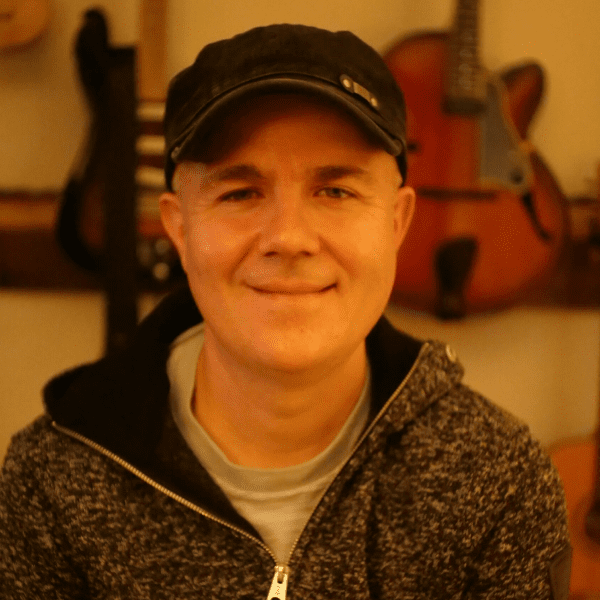When I’m feeling like my ideas are a little stale, I have a few things to try. One is to start writing from a different musical place. I used to always start a tune with a chord progression. I would then arrange it into the style I wanted by sketching it on a sequencer. I’d play the sequence back and try and create a melody afterwards, then try and come up with a form. Lately I’ve had great results starting with a simple melody and then fitting the chords and rhythm section around the melody. I would also say that it is an incredibly valuable skill to have the ability to compose by ear…and by that I mean writing without using an instrument. Guitar is my principal instrument, and as much as I like to use it for sketching musical ideas, my writing would always be limited to what I could play, or how I perceived things on the instrument. In that sense, there are unwanted creative restrictions that are immediately dispelled with the absence of physical limitations. I’m not saying that I want to write a piece of music that I can’t play…just that if I don’t use an instrument and force myself to try and hear things unfold in my head, I eventually come up with things I wouldn’t normally play.
Many of the teachers I had at Berklee would talk about deliberately putting restrictions on what you’re going to write. Our job as the students would be to be as creative as possible within those restrictions. At the time, our primary goal was to get the assignment finished for the next class…whether we liked the tune we wrote or not…lol. There would usually be an assignment to write a tune that incorporated some harmonic/melodic device such as writing in a specific mode or scale, or move the chords around over a pedal point, or limit the number of melody notes you use to only 5 or six notes. Any simple melodic fragment can be reharmonized in many different ways. As time passes since I’ve been away from the student life, I still employ this technique because it can lead to songs I might never have written otherwise.
Other things to try might be starting with a bass line. It could be some ostinato and the chords and melody move over top of it. Maybe start with a melodic fragment and then move it to another key. Maybe experiment with odd phrase lengths. Most music nowadays have 4 bar phrase lengths….why not try 3 or 5? Maybe sketch the form of the song first…how many sections will there be? What style will the music be in? What mood do you want to establish? Will it be slow or fast? What time signature? What will the orchestration. be? Do you want the melody to colour the harmony or vice versa? If you’re daring, maybe write the melody in an unrelated key of the harmony. The result is that you have some sort of bitonal effect….just a possibility……
These are all decisions that will inevitably be made at some point. It’s just a matter of what order they happen in. As simple as these things are, the strength of a composition is equal to the sum of its parts. Great composers pay much attention to the smallest of details…that’s why they’re so great. I strongly recommend to all of my students to listen, listen, listen. While it’s one thing to grasp a musical concept mentally, it’s a whole other thing to use it in a musical way. Hearing the stuff in action through the works of other writers can be beneficial in assimilating a concept in a natural way. Check out classical scores, jazz lead sheets or rock charts. Analyse the chord progressions and how each note functions against the melody. Look for patterns and motifs in harmony/melody, modulations, chord voicings, song form, etc. Look at the instrumentation….what instrument is playing the melody? How are the other instruments functioning? This will in turn influence your own writing.
Final thoughts
To some people all this might sound like a stupid and overly cerebral way of writing. I can tell you that many of the great composers in all genres have used this technique….working within the confines of predetermined limitations, and using their knowledge of music in general to compose. Musical knowledge can be a starting point for the whole piece, or be employed for development of an initial idea. The ultimate goal here is still to write music that sounds good .and doesn’t just look good on paper. Speaking for myself, if I’ve come up with something that’s really cool harmonically, I would never let it out of the barn if the music lover inside me doesn’t dig it. I try to never lose sight of what the listener inside me enjoys most about hearing great music. Like many other musicians, I started listening/playing music at a fairly young age. I certainly had no idea what a Lydian b7 scale was or what polyrhythms were. I just knew how much I loved the way Eddie Van Halen’s guitar sounded and the energy he conveyed when he played….it just totally rocked! Attitude and personality of the player/writer are still a part of the whole package, and if a song is not delivered well, it doesn’t matter how well it was written. I think it was Bill Evans (jazz pianist) that said, “there are no bad songs, just bad players.”

